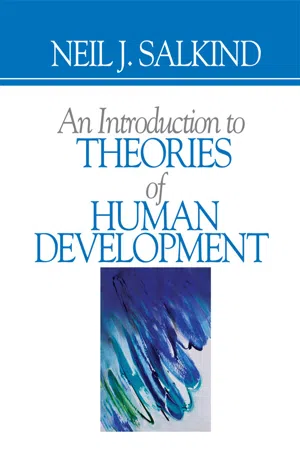Psychology
Behavioral Theory of Personality
The Behavioral Theory of Personality suggests that our behavior is learned through interactions with the environment. It emphasizes the role of conditioning and reinforcement in shaping personality traits and patterns of behavior. This theory focuses on observable behaviors rather than internal mental processes, and it has been influential in understanding how individuals develop and display different personality characteristics.
Written by Perlego with AI-assistance
Related key terms
8 Key excerpts on "Behavioral Theory of Personality"
- eBook - ePub
Behavioral Finance and Investor Types
Managing Behavior to Make Better Investment Decisions
- Michael M. Pompian(Author)
- 2012(Publication Date)
- Wiley(Publisher)
Whether we realize it or not, we describe and assess the personalities of the people around us on a daily basis. These daily musings about how and why people behave as they do are similar to what personality psychologists do. While our informal assessments of personality tend to focus more on individuals, personality psychologists instead use well-developed conceptions of personality that can apply to everyone. Personality research has led to the development of a number of theories that help explain how and why people act the way they do and why certain personality traits develop.While there are many different theories of personality, the first step is to understand exactly what is meant by the term personality . A brief definition is that personality is made up of the characteristic patterns of thoughts, feelings, and behaviors that make a person unique. In addition to this, personality arises from within the individual and remains fairly consistent throughout life.Some of the fundamental characteristics of personality include:- Consistency: There is generally a recognizable order and regularity to behaviors. Essentially, people act in the same ways or similar ways in a variety of situations.
- Psychological and physiological traits: Personality is a psychological construct, but research suggests that it is also influenced by biological processes and needs.
- Impact on behaviors and actions: Personality does not just influence how we move and respond in our environment; it also causes us to act in certain ways.
- Multiple expressions: Personality is displayed in more than just behavior. It can also be seen in our thoughts, feelings, close relationships, and other social interactions.
Now that we've described the basic components of personality known today, let's discuss the very beginnings of the study of personality and take a brief look at the discipline's first practitioners and their contributions to the more modern theorists. This takes us all the way back to Ancient Greece, around 400 b.c. - eBook - ePub
An Introduction to Theories of Personality
7th Edition
- Robert Ewen B, Robert B. Ewen(Authors)
- 2014(Publication Date)
- Psychology Press(Publisher)
PART IVThe Behaviorist Perspective
Overview Behaviorism seeks to make psychology more scientific by studying only what can be observed. It therefore redefines psychology as the study of overt behavior. Behaviorism eliminates from consideration virtually all of what personality theorists consider to be important: inner causes of behavior, wishes, needs, thoughts, emotions, memories, beliefs, expectations, preferences, self-perceptions, unconscious processes, intrapsychic conflicts, dreams. Thus behaviorism is not another approach to personality theory, but rather an alternative to personality theory. Ivan Pavlov First demonstrated the simple form of learning called classical conditioning in his famous experiment with dogs, food, a tone, and salivation. In classical conditioning, the organism learns that one stimulus will be followed by another stimulus because the two stimuli repeatedly occur closely together in time. John B. Watson Also an advocate of classical conditioning, he demonstrated that fear to a previously neutral stimulus can easily be conditioned in his famous experiment with “little Albert.” B. F. Skinner Argued that most behavior is learned through operant conditioning, wherein the organism must make the correct response to be reinforced (receive a reward or avoid punishment). A response operates on the environment to produce consequences that either strengthen or weaken that behavior. If the response is reinforced, it is more likely to occur again; if it is not reinforced, it is less likely to recur. All of our behavior is determined by prior causes and by our environment; we have no free will. Therefore, the only way to change (and improve) our behavior is to design the environment appropriately, so that it will reinforce desired responses and not reinforce undesired responses. How reinforcement is administered (schedules of reinforcement) strongly influences learning and behavior. Even the most complicated behaviors consist of sequences of specific responses that have been learned through operant conditioning. Psychotherapy should be based on behaviorist principles, rather than seeking to change unobservable and abstract inner processes. - eBook - ePub
- Joseph M. Wepman(Author)
- 2017(Publication Date)
- Routledge(Publisher)
For example, one frequently speaks of dominance as a personality trait. A person exhibits dominance in the presence of an acquiescent person, but how does the same person behave in the presence of an equally dominant figure? Traits are at best mere descriptions applied to a general class of responding which appears to share some common characteristics. The fewer traits one defines, the more generalized one has to be and the less accurate one’s predictions will become. Personality tests based on the trait approach have limitations in meeting the predictive aim of psychology. Whenever a prediction is made, it is always within a range of probability, and when the chances of being right nearly match those of being wrong, the predictive value of such an instrument is nil. The exhibition of a trait is based on many responses developed in the conditioning history of an organism and each response could have multiple causes. Thus the effectiveness of a trait description as a predictor of behavior is weakened by the multiplicity of variables involved, many of which are largely unknown to the person making the prediction. It seems more profitable to consider specific responses of an organism and then from the variables known to the investigator predict the response that will occur.3. A Reinforcement Theory of Personality
It is evident thus far from our discussion that the behaviorist’s conception of personality grows out of his interpretation of learning. We have already referred to the application of Hull’s learning theory to personality as expanded in the writings of Dollard and Miller and their colleagues. The student interested in this kind of behavioristic approach may do well to go to the original sources and in particular to Dollard and Miller’s Personality and Psychotherapy (1950). An adequate summary of their position may be found in Hall and Lindzey’s Theories of Personality (1957). We shall present here an alternate approach based primarily on the theoretical position of B. F. Skinner. From our point of view, this approach is preferable because it handles the problems relevant to the study of personality without need for long lists of postulates, hypothetical constructs or intervening variables. Both the positions of Hull and Skinner share at least one point in common, namely, that the conception of reinforcement is of paramount importance although they differ in their interpretation of the principle. The significance of the principle will be explained subsequently.There is no reason to assume that the study of personality offers any new or unique problems for psychology. We can consider the study of personality to be a branch of the general field of learning which investigates in particular those processes significant to human adjustment. To be sure, many contemporary “learning” psychologists prefer to limit themselves to studies of lower animals and are reluctant to use human subjects or to extrapolate their findings to human behavior. Nevertheless, other behaviorists are willing to concern themselves with the problems related to early behavioral development, to motivation, to the effects of aversive stimuli on behavior and the behavioral consequences of frustration and conflict as well as problems of behavior pathology and the role of learning in psychotherapy. It is encouraging to note that today many behaviorists who follow Skinnerian principles are applying their attitudes and methodology to the study of human behavior. Some work at the subhuman level has been given as experimental and demonstrable proof of certain clinical insights. More and more these behaviorists are applying their experimenting to the level of human responding and. discovering principles in their own right instead of merely relying on animal studies alone from which they can extrapolate. - eBook - ePub
Personality Psychology
The Basics
- Stanley Gaines Jr.(Author)
- 2019(Publication Date)
- Routledge(Publisher)
per se (Ewen, 1998). Nevertheless, Pavlov’s theory and research provided much of the conceptual and methodological framework that led to the emergence of the behaviourist school (C. S. Hall & Lindzey, 1978).In the present chapter, we will consider behaviourist perspectives on personality, which are inspired to varying degrees by Pavlov’s (1926/1928) reflexology. We will learn that behaviourist theories – especially B. F. Skinner’s (1938) operant reinforcement theory, which reflects Skinner’s principle of environmental determinism (i.e., throughout individuals’ lives, behaviour can be explained completely by influences that exist outside the individuals; Schellenberg, 1978) – have been criticised for their relative neglect of within-person influences on behaviour. However, we will also learn about certain neo-behaviourist responses – particularly Daryl Bem’s (1972) self-perception theory – that acknowledge the usefulness of personality constructs as related to (but not necessarily causing) individuals’ behaviour.BASIC ASSUMPTIONS UNDERLYING BEHAVIOURIST PERSPECTIVES
A central premise among behaviourist perspectives on personality is the conviction that, in order to understand why individuals speak and act as they do, one must consider the impact of the social and physical environments within which persons engage in particular forms of speech and action (Ewen, 1998). At a minimum, behaviourist theories pose important conceptual challenges to Sigmund Freud’s principle of psychic determinism (i.e., beyond the age of 5 or 6, the speech and action of individuals can be explained completely by influences that exist within those individuals; Schellenberg, 1978). However, behaviourist theories vary in terms of their (de-)emphasis on personality constructs as causes or antecedents of individuals’ speech and action (C. S. Hall & Lindzey, 1978).As noted by J. F. Brennan (2003), behaviourism developed partly as a response to functionalism (concerned with the “how” and “why” of consciousness, or individuals’ mental processes), which was associated with the self-theory of William James (1890/2010) and the instrumental pragmatism of John Dewey (1909). In turn, functionalism had developed partly as a response to structuralism - eBook - ePub
- Neil J. Salkind(Author)
- 2004(Publication Date)
- SAGE Publications, Inc(Publisher)
Behaviorism (the school of developmental psychology based on behavioral models) offers alternative ways of describing how the developmental process takes place. Like Freudian theory, behaviorism has many variants; that is, there are several different behavioral models, not just one. Behaviorists all share the same basic tenet, however: Development is a process that adheres to principles and laws of learning. Biological givens provide some of the foundation for development, but experiences and opportunities to learn are the central and necessary elements that give direction to the process.Although much of behaviorism is based on the early work of the Russian physiologist Ivan Pavlov, behavioral models have been characterized as uniquely American because the scientists who have formulated and applied Pavlov’s basic model have for the most part been Americans. In addition, the central location for advanced research within this field is still in the United States.The term behaviorism encompasses a wide range of behavioral models that vary in the degree of influence they attribute to the environment.Most behaviorists believe that the large body of information that researchers have amassed in studies of how learning occurs can be applied to the developmental process. Most basic undergraduate-level psychology courses devote a considerable amount of time to the study of learning principles, and many students in psychology laboratories have had experience in reproducing the phenomena described by the principles of learning, such as conditioning (more about this later). Although the original evidence for how learning occurs came from laboratory studies, psychologists have elaborated on the rudimentary learning principles developed in labs to account for the behavioral repertoires of children and adults.I want to stress one point before beginning a discussion of the behavioral perspective. Whenever different theorists attempt to explain any phenomenon, there is overlap in the variables they study, the methods they use, and (if there is “truth” in science) their findings. Within any theoretical camp, there is always a great deal of variability among the views of different theorists, although they are basically tied to the same philosophical assumptions. For example, within the broad framework of psychoanalysis, some theorists adhere strictly to the teachings of Freud whereas others reject some of the basic tenets of Freud’s teachings and develop their own ideas. - eBook - ePub
Behavioral Cybersecurity
Applications of Personality Psychology and Computer Science
- Wayne Patterson, Cynthia E. Winston-Proctor(Authors)
- 2019(Publication Date)
- CRC Press(Publisher)
A defender of a cyberattack could benefit from having knowledge of the theoretical conceptualizations that behavioral scientists use to determine a person’s personality traits, personality characteristic adaptations (e.g., motives, goals), and narrative identity as tools at his or her disposal in order to defeat the attack in question. Gaining knowledge about the theoretical conceptualization of personality used by personality psychologists allows those interested in behavioral cybersecurity to explore on their own trends in personality development that derive from ongoing scientific research. Also, with this knowledge, behavioral cybersecurity scholars and practitioners can explore how these dimensions of personality can be revealed from clues manifested from observations drawn from particular cybersecurity cases and scenarios.ReferencesAdhikari, D. 2016. Exploring the differences between social and behavioral science. Behavioral Development Bulletin , 21(2), 128–135.Allport, G. W. 1937. Personality: A Psychological Interpretation . New York: Holt, Rinehart and Winston.Argyle, M. and Lu, L. 1990. The happiness of extraverts. Personality and Individual Differences , 11(10), 1011–1017.Asendorpf, J. B. and Wilpers, S. 1998. Personality effects on social relationships. Journal of Personality and Social Psychology , 74(6), 1531–1544.Bannon, L. J. 1991. From human factors to human actors: The role of psychology and human-computer interaction studies in system design. In J. Greenbaum and M. Kyng (Eds.), Design at Work: Cooperative Design of Computer Systems (pp. 25–44). Hillsdale, NJ: L. Erlbaum Associates.Bannon, L. J. and Bodker, S. 1991. Beyond the interface: Encountering artifacts in use. In J. M. Carroll (Ed.), Designing Interaction: Psychology at the Human Computer Interface (pp. 227–253). New York: Cambridge University Press.Barrick, M. R. and Mount, M. K. 1991. The Big Five personality dimensions and job performance: A meta-analysis. Personnel Psychology , 44, 1–26.Baumeister, R. F. and Leary, M. R. 1995. The need to belong: Desire for interpersonal attachments as a fundamental human motivation. Psychological Bulletin , 117(3), 497–529.Bouchard, T. J., Jr., Lykken, D. T., McGue, M., Segal, N. L., and Tellegen, A. 1990. Sources of human psychological differences: The Minnesota Study of Twins Reared Apart. Science - eBook - ePub
Personality Theories
Critical Perspectives
- Albert Ellis, Mike Abrams, Lidia Dengelegi Abrams(Authors)
- 2008(Publication Date)
- SAGE Publications, Inc(Publisher)
Such animal researchers as Temple Grandin (2005) point out that if animals acquired all of their knowledge via operant conditioning—which in the wild would amount to learning by trial and error, they would be at a distinct disadvantage compared to animals that can learn by observation. Evidence for the ability to learn in this way can be seen in an African Grey parrot that learned concepts by observing laboratory assistants being rewarded with parrot treats when they identified colors. Before long, the parrot not only was able to learn the concept of colors and shapes but even asked about his own color. Humans, parrots, and moving down the phylogenetic spectrum, even bacteria have characteristic behaviors that require little or no conditioning. The preponderance of evidence indicates that it is not to the advantage of organisms to begin life as a blank slate. All species are born with some behavioral predilections, and most species are more readily conditioned to some stimuli and less to others, according to the evolutionary demands that their ancestors faced. Because different evolutionary milieus yielded different behavioral inclinations, it follows that the behaviorist premise that learning can be generalized from any animal to humans is highly questionable. In fact, even within a single species, the penchant for learning certain behaviors differs. For example, it is far easier to condition a golden retriever to retrieve than it is a pomeranian.But behavioral theories need not be discarded together with their inflexible radical dogma. The behaviorists contributed a great deal to the advancement of psychology, the understanding of personality, and the treatment of neurotic disorders. The modal psychotherapeutic approach, and the one advocated by the authors of this text, is cognitive-behavioral. Both terms are emphasized, as the treatment of personality and emotional disorders requires the patient to change both thought patterns and behavioral habits. Behaviorist psychology contributed a great deal to the understanding of that portion of personality that results from learning. It also became the foundation of the most effective clinical approach to treating personality and other psychological disorders. - eBook - ePub
Foundations of Counseling and Psychotherapy
Evidence-Based Practices for a Diverse Society
- David Sue, Diane M. Sue(Authors)
- 2012(Publication Date)
- Wiley(Publisher)
Chapter 11
Cognitive-Behavioral Theory and Techniques
My approach to psychotherapy is behavioral, such that I conceptualize the development and maintenance of behaviors according to learning theory (operant conditioning, classical conditioning, etc.). I view the context in which the behavior occurs as critical to accurate conceptualizations and change…. My interventions pull from empirically-supported treatments and principles that are targeted to my behavioral formulations … (Wagner, 2005, p. 101)Cognitive-behavioral therapy (CBT), now advocated by many in the mental health profession, is rapidly becoming the treatment of choice for many disorders. For example, when 85 psychiatric residents were surveyed regarding therapeutic practices, nearly all rated CBT as “clinically useful,” 99 percent anticipated using it in future practice, and all were aware of the research evidence favoring CBT (Cassidy, 2004). For the profession of psychiatry, this shift in favor of cognitive-behavioral approaches is dramatic because psychiatry has traditionally been influenced much more by psychodynamic theories. The increasing emphasis within the mental health profession toward evidence-based practice and the requirement of managed care for short-term treatments with specific goals and interventions has resulted in growing awareness and use of cognitive-behavioral therapies. The clinician quoted above clearly bases her approach on learning theory and interventions that are empirically supported. In fact, the vast majority of empirically supported psychological interventions are some variant of the cognitive-behavioral approach.Although some differences exist within the different cognitive-behavioral therapies, they are similar in that they extol the virtues of the scientific method and research evidence. Many of the principles and constructs underlying CBT are derived from experimental research. There is emphasis on the importance of observation, the use of objective measures, and the careful evaluation of the process and outcome of therapy. As with the humanistic therapies, CBT focuses primarily on present influences on behavior rather those from past issues. In general, most behavior theorists believe that humans are shaped by environmental variables. In contrast with the humanistic and psychoanalytic approaches, cognitive-behavioral therapies often have clients actively involved in their treatment by practicing skills learned during therapy.
Learn about this page
Index pages curate the most relevant extracts from our library of academic textbooks. They’ve been created using an in-house natural language model (NLM), each adding context and meaning to key research topics.







